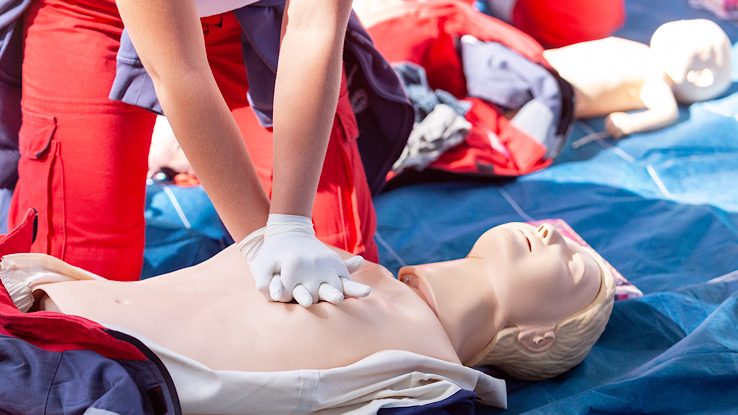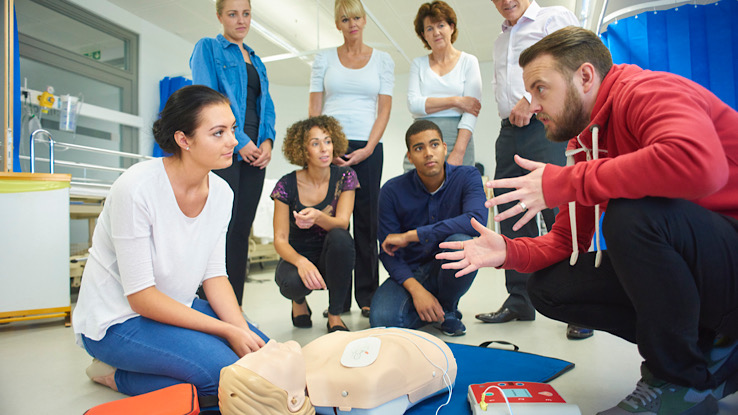The Abbreviation Cpr Stands For

In an emergency, existence able to perform cardiopulmonary resuscitation (CPR) can help save a life. CPR is an emergency procedure that consists of chest compressions and frequently assisted ventilation to maintain the circulation of oxygenated blood if an individual'southward heart or breathing stops. Immediately starting CPR and conveying it out until trained medical staff arrives can substantially increase an private's chances of survival and improve their overall outcome. Therefore, getting CPR certified could be the all-time thing you've ever done because you never know when you may need this life-saving skill.
Before start CPR, you should:
- Ensure that the environment is safe.
- Check for responsiveness, breathing, bleeding, or other serious conditions in the individual.
- If the individual is unresponsive and is not breathing or having difficulty animate, immediately phone call 911 or take someone else practice it if yous are not alone.
- Go into the correct position to perform CPR:
- Place the private on their back on a firm, apartment surface.
- Kneel adjacent to the private'south shoulders.
- Identify the heel of 1 of your easily over the middle of the private's chest (betwixt their nipples).
- Identify your other hand on tiptop of the one already placed on the individual's chest.
- Keep your shoulders directly over your hands and keep your elbows locked.
Next, you should know that at that place are two versions of CPR: hands-only CPR and conventional CPR. Easily-only CPR, as well called pinch-only CPR, can be performed by anyone (even if you are not CPR certified). It is performed by providing chest compressions at a constant rate without breathing assistance.
Hands-Only CPR
To perform hands-merely CPR:
- Follow the procedures listed above and get into the correct position.
- Using your entire torso weight, push straight down on the private's chest with a depth of at least 2 inches but no more two.iv inches.
- Subsequently each compression, permit the private's breast to return to its starting position.
- Proceed compressions at a rate of 100 to 120 compressions per infinitesimal (to the beat of the song "Stayin' Alive") until aid arrives or the private recovers.
When performing hands-simply CPR, information technology is well-nigh important to recollect to:
- Call 911
- Push difficult and fast in the center of the individual'southward chest.
Conventional CPR
Conventional CPR is also sometimes called high-quality CPR. Healthcare providers and trained individuals perform it, only you can exercise information technology too. It consists of providing chest compressions and rescue breaths at a xxx:ii ratio.
To perform conventional CPR:
- Follow the initial procedures listed above and get into the correct position.
- Employ C-A-B (compressions, airway, breathing) to help remember the steps.
- Compressions: give 30 chest compressions at a rate of 100 to 120 per minute.
- Push straight down on the individual's chest using your unabridged body weight.
- Each compression should have a depth of at to the lowest degree 2 inches but no more than 2.iv inches.
- Allow the individual'due south chest to return to its starting position after each compression.
- Airway: open the individual'southward airway past gently lifting their chin and tilting their caput back.
- Animate: give two rescue breaths.
- Create a seal over the individual's mouth using your mouth or a bag-mask device (if available).
- Pinch the private's nostrils closed.
- Provide the offset rescue breath and observe if the individual's chest rises.
- If the individual'south chest rises, provide a second rescue breath.
- If their breast doesn't rise, recheck their airway (An object may be blocking it).
- Each rescue breath should last only 1 2nd and should non be provided with as well much forcefulness.
- Rescue breaths can be provided via the individual's nose if their oral cavity is seriously injured.
- Repeat C-A-B until help arrives or the individual recovers.
When performing conventional CPR, it is most important to remember to:
- Employ correct manus placement.
- Avoid interruptions in chest compressions.
- Provide compressions at a sufficient rate and depth.
- Avoid leaning on the individual in between compressions.
- Prevent over ventilation.
Even if y'all are not trained or certified in CPR, it is e'er better to do something rather than nothing at all if yous find yourself in a situation where an individual needs emergency assist. If yous lack the grooming or confidence needed to attempt conventional CPR, hands-only CPR should at least be attempted. Remember that taking quick activity tin salvage someone's life!
How Can I Get CPR Certified?

If you are at present convinced to become CPR certified, there are many options bachelor. Many classes are offered in-person, online, or fifty-fifty in blended formats. About CPR classes provide the basic information and instruction needed to perform this emergency process and can typically be completed in but a few hours.
How Can I Get CPR Certified?
However, some things should be considered when deciding which class is correct for you. For case, in-person classes provide hands-on skill training and allow you to enquire the instructor questions. In dissimilarity, online courses are usually self-paced and tin be completed anywhere. Additionally, some CPR classes may target specific audiences, such as healthcare professionals, and may include more in-depth information and training. Nonetheless, diverse online search tools, such as the ones supported by the American Cherry Cantankerous and American Center Association, can be used to discover reputable CPR certification classes nearly y'all.
Beyond CPR: Basic Life Support (BLS) Training
Basic life back up (BLS) consists of a set of emergency procedures that tin be performed on an individual experiencing cardiac or respiratory distress. In improver to loftier-quality CPR, BLS grooming covers how to use an automated external defibrillator and remove airway obstructions in individuals of all ages.
Withal, BLS training extends beyond the physical skills needed to perform these emergency procedures and teaches disquisitional thinking and problem-solving skills. Information technology is required for start-responders and healthcare and public condom professionals, just anyone tin can get BLS certified. Because BLS certification requires more in-depth training and yous must demonstrate competency in executing certain emergency procedures, classes are usually offered in person or a composite format. If yous think you want to get BLS certified, the same online search tools mentioned above can be used to find classes offered in your area.
Resource Links:
- "What is CPR" via American Heart Association
- "CPR Certification" via American Red Cantankerous
- "BLS Grooming" via American Cherry Cross
- "Basic Life Support" via American Heart Association
- "Cardiopulmonary Resuscitation (CPR)" via Mayo Clinic
The Abbreviation Cpr Stands For,
Source: https://www.thehealthfeed.com/healthy-living/be-prepared-to-save-a-life-get-cpr-certified?utm_content=params%3Ao%3D1668962%26ad%3DdirN%26qo%3DserpIndex&ueid=cf327fd6-a40e-43a0-bfa4-0c81559581d1
Posted by: gasparddienteor.blogspot.com


0 Response to "The Abbreviation Cpr Stands For"
Post a Comment